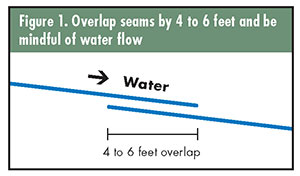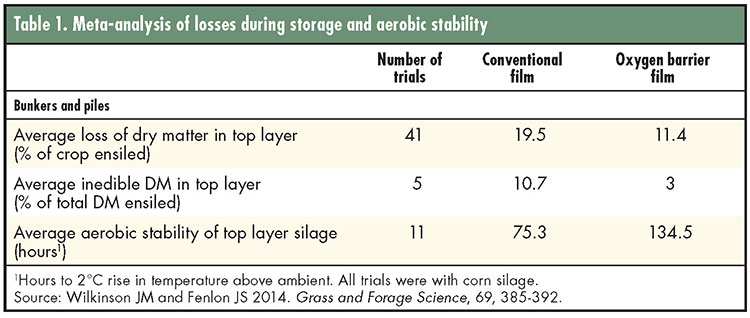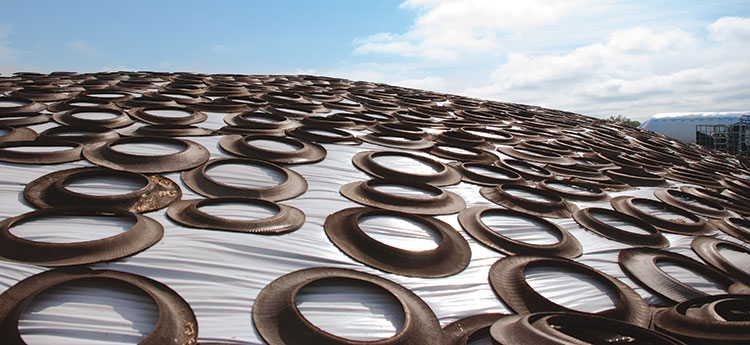Like a Ferrari, peak silage performance requires protection |
| By Chris Wacek-Driver |
|
|
The author owns and operates a forage consulting business, Forage Innovations LLC, in Bay City, Wis. When filling a bunker or pile silo, paying attention to details and preplanning can pay huge dividends. Focus. Sitting down to look at a Google map of a dairy’s feed pad, hoping to optimize the layout of projected forage crop yields and inventories, my mind wandered. The cost of the forage required to feed today’s dairy herds is staggering. A single cutting of haylage can exceed half a million dollars in value, while larger piles and an entire year’s forage can reach into the millions. More astonishing, unlike my grandfather’s farm, we no longer protect this tremendous inventory with concrete and steel. Instead, our modern methods hope to maintain that investment under what is often a single layer of plastic and mounds of tires. Really? Do we really think about this risk or just accept it as normal? Jon Orr, a custom harvester out of Ohio, equated the monetary value of multiple silage piles sitting on a large, open feed pad to having several Ferraris sitting out on an open lot. The average Ferrari owner likely takes great pains to care for and maintain their investment, including a garage to protect it. That thought process should be similar when protecting our forage. Just as a Ferrari loses value if not properly maintained, inadequate forage protection or management can cause invisible losses, slowly eroding away valuable equity. It doesn’t matter if your forage pile value equates to that of a Ferrari or a well-loved farm truck. Significant effort, time, labor, and money is necessary to get a crop to storage. Ultimately that investment needs to be maintained for several months and, occasionally, years. When ordering a new car or truck, time is spent on details like accessories. Preparing for the new year’s crop involves details such as selecting the correct seed, figuring the labor required, deciding on the correct machinery needed to prepare the ground, and planting and harvesting the crop. We pray Mother Nature gives us ample opportunity to harvest at the optimal maturity and nutrient availability. We agonize over the proper chop length and moisture and spend significant time working around the weather to get the crop in. Calculations are done on the right amount of pack weight and training is provided on proper packing technique. Harvest season, with its minutia of detail and uncertainty, can be tremendously fulfilling, hopeful, stressful, and chaotic all within the same day. It is tempting to look at that final pile, maybe breathe a final sigh of relief or satisfaction, and feel the biggest part of the work is done. Yet, covering decisions and techniques are just as important. The materials used and covering methods will have a significant impact on the initial fermentation and resulting forage parameters of your crop. Long-term storage dictates careful choices to maintain and reduce the risk of your multi-figure forage investment, just as a garage is for an expensive Ferrari. It takes planning Covering piles requires careful planning. Serious thought is put into the process and detail: Who is in charge? What type of shoe is suitable for walking on plastic? Is the covering material strategically placed to minimize manual labor? A brief training session, prior to the day of covering, helps reinforce the value of the forage, each worker’s role, and the risk of a job improperly done. Most personnel, once they understand the value and importance of the job ahead of them, exercise more care around the pile. Covering piles is hard work and being efficient helps speed the process along. Having team leaders strategically placed on or around the pile can help the process. Paying attention to little details can pay huge dividends. Have several extra pairs of work gloves readily available along with extra tape to patch holes (that will occur). Also, having plenty of fluids accessible can help make the covering process more tolerable. Communication of subtle details like keeping the plastic low to the ground to prevent it from parachuting can help alleviate frustrations. These meetings are also the place to remind staff of the dangers of working with slippery plastic, to wear visible clothing around machinery and moving tires, and the danger of falling. Create a seal The most critical step of covering and sealing is establishing the outer seal. Envision when your nutritionist takes a forage sample, puts it in a bag, pushes out as much air as possible, and zips it up. A similar process needs to occur around the outer perimeter of a pile or bunker. To create a tight outer seal, there needs to be plenty of plastic to reach to the edges and beyond. During this process, we want to push out as much air as possible and put heavy weights around the edges. The place to skimp on plastic is not at the bottom of a pile or edge of a bunker. If using two layers of plastic, both layers need to stretch fully to the bottom and beyond. On piles, a minimum of 2 feet of plastic, flat on the ground and covered by a solid line of heavy weight, is desirable. Limestone screenings work better than sand, which can wash away, and can quickly be moved into place by a skid steer. Gravel-filled bags, larger whole tires, cow mats, or multiple tires stacked on top of each other have been used successfully as well.  Numerous studies point to the benefits of quickly sealing the forage pile to initiate fermentation immediately after packing is complete. Follow the same rules of packing as with the rest of the pile. Spread in thin layers and spend a little extra time to finish packing and smooth the pile so plastic and tires have a place to rest evenly. Then, get that first layer of plastic down. Given that harvest doesn’t always coincide nicely with other people’s schedules or daylight hours, the full number of tires or the final cover can be placed later if timing of covering is not convenient. If the plastic is securely sealed on the edges, final weights can be placed later. By later, we mean hours or a couple days — not weeks. If the farm wishes to cover in nighttime hours, make sure there is adequate lighting. Some farms have installed overhead lighting for this purpose and/or rented additional portable lights as needed. One last point about sealing: Once the pile is opened for feeding, keep the cut edge of plastic sealed down with heavy weights. Air infiltration under the plastic at the feeding face is a leading cause of spoilage seen on farms. Don’t skimp on plastic When choosing covering materials, it is tempting to choose the less expensive plastic or an easier covering method. Carefully consider the economic investment under your covering choice. The last thing you want is for invisible thieves to help themselves to your valuable nutrients and dry matter. True oxygen barriers have proven themselves in multiple trials to reduce top layer nutrient loss, shrink, and mitigate inedible waste silage. Trials have also shown oxygen barriers enhance aerobic stability and hygienic quality by reducing yeast, mold, and butyric spore formation. In one meta-analysis (41 trials) with a true oxygen barrier plastic, dry matter loss was reduced in the top layer by 8.1% (see Table 1). In the same meta-analysis (11 trials), average aerobic stability (time to heating) was lengthened by nearly 2.5 days.  Don’t be fooled by imposters. Oxygen barrier plastics are not just thin polyethylene sheets of plastic. They have specific polymers to limit oxygen infiltration and are composed of several microscopic layers. Think of a sub sandwich. The oxygen barrier compound would be the “meat” of the sandwich. Since the polymers that make up the oxygen barrier do not bind to polyethylene, more polymers are needed to stick them to the outer polyethylene layers. These polymers could be thought of as the mayo and mustard components (glue) of the sandwich. The “bread,” or outer layer of the plastic, is polyethylene. Very few companies have the complex equipment to make 7- to 9-layer plastics. Unfortunately, some of these companies have marketed thin polyethylene “painter’s” plastic under the term vapor barrier claiming the same benefits of oxygen barriers. One well-designed study clearly showed the difference between two layers of polyethylene plastic and a layer of polyethylene and oxygen barrier. Commercial agriculture plastic composed of primarily polyethylene is not a great barrier to oxygen. The wise purchaser will do their homework, given the huge cost of the forage investment, and will ask for research on a specific product and verify it is a true oxygen barrier. We certainly don’t want to skimp on the building materials covering our Ferrari!  Oxygen-barrier plastics contain specific polymers that inhibit oxygen penetration through the surface. Another approach There are many reasons to want to move away from plastic and tires, and environmental concerns top the list. While a myriad of methods have been pursued, one method that has gained traction has been the use of reusable mesh covers. These tough, UV-protected woven covers have proven useful in preventing bird and hail damage to plastic and discourage critters from climbing on the pile due to their claws catching in the mesh. If manufactured, handled, and stored properly, reusable woven covers can be long-lasting and economical. From a sustainability standpoint, woven covers have the potential to cut plastic usage by two-thirds. Having been proven for many years in the European market, these mesh covers are gaining traction in the U.S. Admittedly, those in Northern climates dealing with snow and ice will have to deal with covers freezing in the winter. Those who have persevered have utilized methods such as removing the mesh cover prior to a winter storm and not bringing the mesh covers to the sides of the bunker or bottom of the pile to facilitate removal. Lastly, like the Ferrari, ongoing maintenance of the pile is necessary. Having a regular schedule to inspect and repair damage to the plastic is critical over the life of the pile. Small holes or breaks in the outer seal can cause extensive spoilage and loss. Keeping tools close by, such as repair tape in machinery or buildings at the storage site, can encourage quick repair by employees and maintain that forage investment. This article appeared in the August/September 2020 issue of Hay & Forage Grower on pages 10 to 12. Not a subscriber? Click to get the print magazine |
